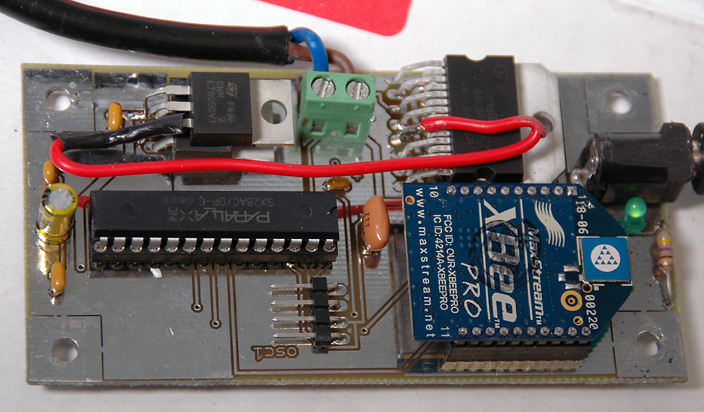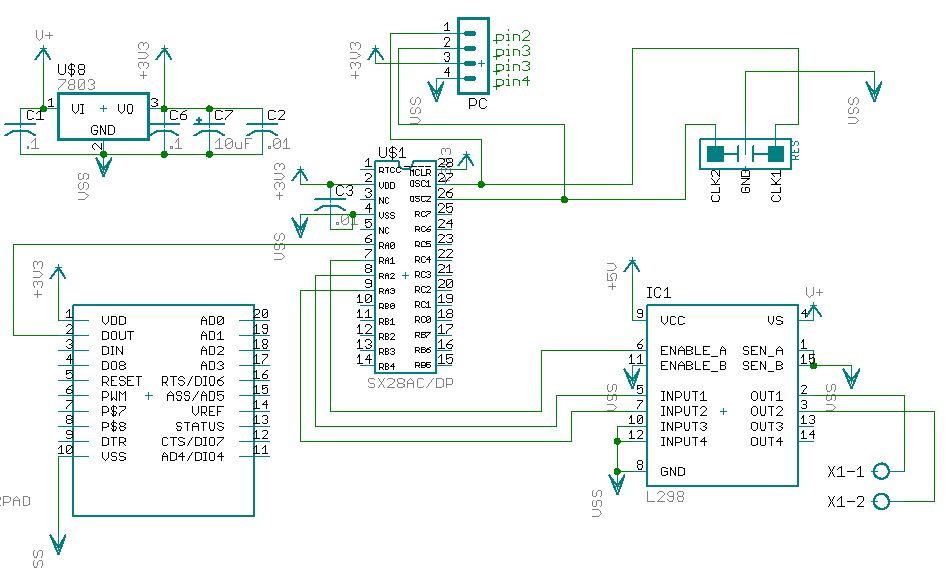Anyone with L298 experience?
I have a circuit with an SX28 driving an L298 and a DC motor. I am using only one side of the L298 in the identical circuit shown on their data sheet. The exception is I don't have any diodes in the circuit or the 100nF cap on the outs. I may add them if needed, but I thought they were foruse when chopping the current.
The SX28 is at 3.3v
L298 Logic Voltage is 5 (I originally had it at 3.3v but it ddn't work, so I stacked a 7805)
Vs is at 15 (motor supply)
I am using a 12DC unregulated 2amp supply, actual 15 volts
L298 motor output is only 8 volts when on
The motor runs strong directly off the supply, but weak off the 298. There is no PWM in the circuit, no current limiting, no sense resistors. I thought it would just pass the 15v and GND the same as the direct connection, but it is not as strong. If I hold the motor on for over 10 seconds the L298 gets hot, and has even thermally shut down. Before it shut down the speed was less and less to a crawl.
I did not bump the SX 3.3v up to the L298 5v as I think it should be fine, and it does turn it on.
Any suggestions would be great on what might be happening to cause the weak power and heat. These chips are suppose to handle 4 amps.
Thanks
Todd
Post Edited (originator99) : 9/21/2006 10:45:58 AM GMT
The SX28 is at 3.3v
L298 Logic Voltage is 5 (I originally had it at 3.3v but it ddn't work, so I stacked a 7805)
Vs is at 15 (motor supply)
I am using a 12DC unregulated 2amp supply, actual 15 volts
L298 motor output is only 8 volts when on
The motor runs strong directly off the supply, but weak off the 298. There is no PWM in the circuit, no current limiting, no sense resistors. I thought it would just pass the 15v and GND the same as the direct connection, but it is not as strong. If I hold the motor on for over 10 seconds the L298 gets hot, and has even thermally shut down. Before it shut down the speed was less and less to a crawl.
I did not bump the SX 3.3v up to the L298 5v as I think it should be fine, and it does turn it on.
Any suggestions would be great on what might be happening to cause the weak power and heat. These chips are suppose to handle 4 amps.
Thanks
Todd
Post Edited (originator99) : 9/21/2006 10:45:58 AM GMT





Comments
▔▔▔▔▔▔▔▔▔▔▔▔▔▔▔▔▔▔▔▔▔▔▔▔
Don't visit my new website...
I had thought that maybe driving the L298 (which is using a 5volt logic supply) with the SX 3.3v might be a problem, so I pulled the SX out and tested the circuit driving the L298 with 5 volts off the 7805, it did give a slight improvement, but not near the performance of using the motor conected straight to the supply.
Also the L298 gets quite hot within 30 seconds of continuous use. If the motor isn't even operating at full speed/amp rating, how is it the L298 is overheating?
Post Edited (originator99) : 9/21/2006 7:57:55 PM GMT
▔▔▔▔▔▔▔▔▔▔▔▔▔▔▔▔▔▔▔▔▔▔▔▔
Chris Savage
Parallax Tech Support
I added the diodes but no change.
The way I read it you need another supply voltage switch that switches only when the enable input is low.
I would disconnect the load and drive a 12V bulb , see what your voltage is on the output and if the chip heats up, it is possible the chip is damaged because of not having the diodes in place when you originally powered it up.
▔▔▔▔▔▔▔▔▔▔▔▔▔▔▔▔▔▔▔▔▔▔▔▔
Think outside the BOX!
I tried a 12v 6 amp supply, it ran slow, chip got hot.
I put a 1200mA supplty to it, it runs much slower,and chip gets hot.
If the supply can push the motor no problem with a direct connection, should not the L298 simply pass along the same current up to it's max capacity of 2 amps per side? I tried paralleling them earlier and got a slight improvement, but not adequate.
The motor is rated at 350mA at no load, 4amps at max load of 40 pounds. I have maybe 2 pounds if that. So there is no real load. I was reading .850 earlier with the 2amp supply. Maybe someone with some EE background might understand how a chip can run hot when pushing a motor that has no load.
I tried a 24 v 1.5 amp supply and smoked a L298. It is rated for 46 volts! I hate mysteries like this.
PS I think what that quote means is that you shoud not apply ENABLE without having a supply voltage.
I am about to punt and use a relay, this is a big hassle that it doesn't just work according to the datasheet. There could be something I am missing but 10 hours is enough already.
Post Edited (originator99) : 9/22/2006 4:13:59 AM GMT
http://www.datasheetcatalog.com/datasheets_pdf/R/F/P/3/RFP30N06LE.shtml
Also do you have the cap on VSS?
Supply Voltage for the Logic Blocks. A100nF capacitor must be
connected between this pin and ground.
▔▔▔▔▔▔▔▔▔▔▔▔▔▔▔▔▔▔▔▔▔▔▔▔
Think outside the BOX!
Post Edited (metron9) : 9/22/2006 2:00:25 PM GMT
The spec sheet says the L298 is rated for 4 amps, but that is only possible with a proper heatsink.
I would suggest that you mount the chip on a heatsink having a thermal resistance of less than 10degC/watt.
Digi-Key #294-1080-ND or #HS114-ND would do the job.
Also, the L298 spec sheet says that VCEsat total can be as high as 3.2V@1amp and 4.9V @2amps. Which means
that you can be losing up to 4.9V through the chip. You can check the loss by measuring the final voltage across the motor.
You may have to boost up the power supply voltage to get full voltage.
You should use at least #20 wire for all the high current wiring, to cut losses.
DaveG
L298 motor output is only 8 volts when on
If your supply is 15V, that means that there's a 7V drop through the L298, when the specs show 4.9V max drop under a 2A load. This tells me that you're trying to drive more than the 2A max through the driver (2A max DC per channel, 4A max per chip). If this is still the case for your updated circuit, the motor is most likely rated for a higher voltage than is available through the L298 under load, so it is sinks even more current which pulls the voltage even lower. This would also explain why the chip heats up so quickly.
For a quick check, measure Vs across the L298 under load and compare to the voltage drop across the motor drive outputs. If the difference is 5V or more, the L298 is being driven past maximum ratings.
You could provide 5volt pullups even though the SX is at 3.3volts because th SX will easily tolerative up to 6 volts on any I/O pin. The SX will pull down when a low state is needed and let it go to 5v when not. This may not be ideal when you initially turn on the device while the pullups dominate the L298s logic until the SX intializes.
While complete IC H-bridges seem to be a neat idea, they are severely limited by heat buildup. You can use a logic chip as a front-end and four darlington power transistors or four MOSfets, to get much better H-bridges.
Trying for a compact design with no heatsink is just working against you. Power MOSfets require less heatsink than the BJTs or Darlingtons, but power switching always has heat issues.
Even the tiny Tilden H-Bridge of 6 transistors can be thermally superior to the L298, though it doesn't do 4amps continuously though in a PWM mode it may handle your 4 amp requirement.
▔▔▔▔▔▔▔▔▔▔▔▔▔▔▔▔▔▔▔▔▔▔▔▔
It's sunny and warm here. It is always sunny and warm here.... (unless a typhoon blows through).
Tropically, G. Herzog [noparse][[/noparse] 黃鶴 ] in Taiwan
Post Edited (Kramer) : 9/29/2008 3:37:54 AM GMT